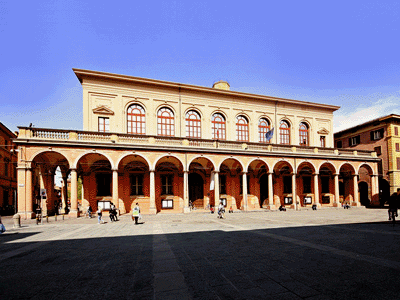
By ANDREW POWELL
Published: March 25, 2016
BOLOGNA — Two years ago all was bleak in music circles here. Orchestra Mozart had folded. Claudio Abbado died. Teatro Comunale lumbered toward a fiscal guillotine mandated by the government. Now, the sun is back, much of it radiating from the reorganized opera house where Nicola Sani holds sway as sovrintendente. Certain theater functions have been outsourced, yet Sani retains his unions’ visible cooperation. The nation, the region and the comune (900 years old this year) underwrite his artistic program, as do private firms, starting with Bologna-born Automobili Lamborghini S.p.A., which parks a silver specimen in the foyer (called Foyer Respighi after the native composer, not Foyer Lamborghini). House income and expenses are perusable online. Tickets are affordable. An intermission glass of water (in a glass) costs 50 euro cents, the fresh torta di mele two euros. Not surprisingly Teatro Comunale is constantly full, its cheerful buzz spilling out onto Piazza Verdi and into the adjacent student-frequented cafés; any student can attend, and everyone knows it. Opera crowds, young and old, dress with a kind of sloppy elegance, as if perfect colors and fabrics chose themselves, but the listening is attentive — which is just as well because Sani offers two aces: direttore musicale Michele Mariotti, probably the most “complete” young Italian conductor around, and maestro del coro Andrea Faidutti, builder of an outstanding, musically alert team. For this season’s Attila (heard and seen Jan. 30 and 31) and Beethoven’s Ninth Symphony (Feb. 7) both were busy.
Newly staged by Daniele Abbado and co-produced with Teatro Massimo di Palermo and Teatro La Fenice di Venezia, the Verdi unfolded amid gloomy gray panels depicting nothing much, its action scheme stand-and-sing. Two quartets of principal singers enabled seven performances here in nine days, the first one (Jan. 23) televised by RAI. On Jan. 30, Stefanna Kybalova sang an agile, powerful Odabella; Giuseppe Gipali phrased Foresto’s music handsomely, though his voice went to the sides, not forward; and Gezim Myshketa intoned incisively as Ezio. Riccardo Zanellato’s obsessive invader sounded remarkably smooth and warm, with plenty of capacity; acting is not his strong suit. The next night the cast of the prima returned, except that Ildebrando d’Arcangelo’s dramatically vivid, but in the long lines unsteady, Attila did not make it past the Prologue. Jumping in, Zanellato this time moved and sang a little more wildly in his portrayal, without loss of vocal opulence. Maria José Siri’s Odabella had expressive power and a degree of magnetism, while Fabio Sartori’s awkward, rotund Foresto dealt only in f, ff and fff. The Jan. 31 Ezio proved especially fine, singing with imagination and reserves of power; Simone Piazzola is the name. Mariotti presided over a somewhat undersized string section, so that the score’s cantabile qualities were impaired. (Attila is at least his fourth Verdi opera, after Simon Boccanegra, Rigoletto and Nabucco, and this month he adds I due Foscari in Milan.) But his reading had conviction and sweep, and on both evenings he and the orchestra — more than any cast member — drew the loudest, longest applause.
If anything, Mariotti had more to say about Beethoven’s symphony. Conducting with a concern for lyricism that never softened the rhetoric, he drew virtuosic work from the Orchestra del Teatro Comunale strings and, as in Schubert and Mendelssohn last year, picked out just the right details to create a beautiful and cogent interpretation. Upshot: rhythmic applause, foot-stomping, smiles all round. At 68 minutes with brief pauses, Mariotti’s Nona was neither fast nor slow but merely the sum of apparently artlessly judged tempos. The first movement’s turbulent exchanges emerged in plain relief despite intermittent problems in the winds. The conductor sprang the Scherzo’s rhythms emphatically, playing up contrasts and accentuating colors. He ennobled the third movement on pastoral, not grandiose, terms, drawing attention to collateral ideas. Through the last movement, he kept a steady momentum without slighting the episodic drama or exaggerating one dimension at the expense of another. Faidutti’s choristers projected forcefully into the comfortable 1,034-seat house, but their work also had precision and plenty of shading, in discernible German. Vocal soloists Carmela Remigio, Veronica Simeoni, Michael Schade and Michele Pertusi neatly complemented their colleagues.
Photos © Rocco Casaluci (Attila), Michele Lapini (Beethoven concert), Teatro Comunale di Bologna (Piazza Verdi)
Related posts:
Mariotti North of the Alps
Parsifal the Environmentalist
MKO Powers Up
Carydis Woos Bamberg
Time for Schwetzingen